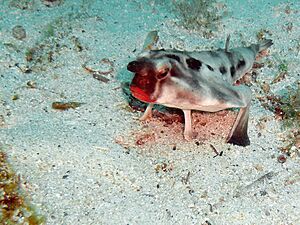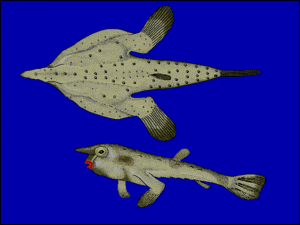Red-lipped batfish facts for kids
Quick facts for kids Red-lipped batfish |
|
|---|---|
 |
|
| Off the Galápagos Islands | |
| Conservation status | |
| Scientific classification |
The red-lipped batfish or Galápagos batfish (Ogcocephalus darwini) is a very unique fish. It lives around the Galápagos Islands and off the coast of Peru. You can find it in waters from about 10 to 250 feet deep.
This fish is famous for its bright red lips, which look like they're covered in lipstick! Batfish are not great swimmers. Instead, they use their special fins to "walk" on the ocean floor. When a batfish grows up, its top fin changes into a single spine. This spine helps it to attract food.
Contents
What is a Red-Lipped Batfish?
The red-lipped batfish was first officially described in 1958. This was done by an American fish expert named Carl Leavitt Hubbs. He found the first one near Isabela Island in the Galápagos.
This batfish belongs to a group of fish called Ogcocephalus. These fish are part of a larger family called Ogcocephalidae. They are also related to anglerfishes, which are known for their unique ways of catching prey.
Why is it Called That?
The name Ogcocephalus comes from two old Greek words. Ogkos means "hook," and cephalus means "head." This name probably refers to a pointy part on the front of the batfish's head.
The second part of its scientific name, darwini, honors Charles Darwin. This was done to celebrate 100 years since his famous book On the Origin of Species was published. It also recognizes how important his observations in the Galápagos Islands were for understanding how species develop in specific places.
What Do Red-Lipped Batfish Eat?
Red-lipped batfish are meat-eaters. They mainly eat other small fish. They also enjoy small creatures without backbones, like shrimp, crabs, worms, and mollusks. They find all these tasty snacks on the seafloor where they live and hunt.
How Does a Red-Lipped Batfish Look?
The red-lipped batfish can grow up to 16 inches long. Its body is light brown and grayish on its back. Its belly is white, which helps it blend in with the light from above. This is called countershading.
There is often a dark brown stripe running from its head down its back to its tail. The front part of its head, called the snout, is brownish. Of course, its most striking feature is its bright, almost glowing, red lips!
The skin of the batfish feels a bit rough, like sandpaper. It has small, hidden bumps that are covered with tiny spines.
On top of the batfish's head, there is a special part that sticks out. It's called an illicium. When the red-lipped batfish is fully grown, its top fin turns into this single spine-like projection. The batfish uses this illicium to attract prey close to it.
At the very tip of the illicium is a part called an esca. This esca can glow brightly. Since these fish live in deeper waters where it's dark, the light attracts other small fish. These curious fish swim closer, and then the batfish can easily catch them for a meal.
The very bright red lips of the batfish help people tell them apart from other types of batfish. Scientists think these bright red lips might also help batfish recognize each other when they are ready to reproduce.
Where Do Red-Lipped Batfish Live?
Red-lipped batfish live in the Pacific Ocean. You can find them around the Galápagos Islands and off the coast of Peru. They usually live in waters from about 10 to 250 feet deep.
They are "bottom dwellers," meaning they spend most of their time on the sand or ocean floor. Sometimes, they might swim up closer to the surface, even over very deep water. They often hang out near the edges of coral reefs, sometimes as deep as 400 feet.
Who Are Their Predators?
The red-lipped batfish does not have many known direct threats from other animals. However, big changes in the ocean could harm them. For example, rising sea temperatures and coral bleaching could change their natural home. This might also reduce the amount of food they can find.
Images for kids




